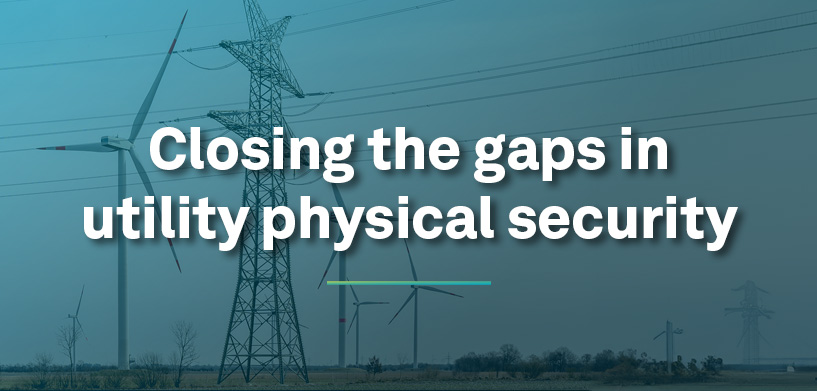In March 2024, arsonists set fire to a German Tesla factory’s electricity tower. Factory production stopped and the surrounding communities lost power. The arsonists’ ability to access the factory’s infrastructure highlights the importance of utility physical security.
For instance, what enabled these arsonists to do what they did? Did siloed data keep the right teams from knowing what to do and when? Did legacy technology miss an opportunity to send an alert? As regulations to protect critical infrastructure increase, utilities are being pushed into a future with modernized physical security management.
Physical security regulations are changing
Regulations for critical infrastructure are changing. North American Electric Reliability Corporation (NERC) or country-specific regulatory frameworks like Germany’s Verordnungen für Kritische Infrastrukturen (KRITIS) are setting the standard for how utilities operate their security systems.
Many current physical security systems include legacy technology, siloed data and geographically remote systems. With changing regulations, all current data needs to be integrated to create a universal picture in physical security systems. Utility organizations must close the gap between the technology they have and the technology they need.
“The initiatives to create a critical infrastructure protection framework are the primary reason why physical security is important to utilities,” said Andreas Conrad, vice president of marketing, physical security for Hexagon’s Safety, Infrastructure & Geospatial division. “Regulations from organizations like NERC are setting the standard for utilities and that’s what drives the investments into physical security. Utilities’ legacy technology leaves them with a large gap to close to meet those requirements.”
While utilities are already burdened with evolving regulations, an increasing number of renewable energy assets is widening the scope of what needs to be protected and adding to physical security requirements. Utilities need to address the vulnerabilities of renewables while adapting to current standards.
Renewable energies are increasing network vulnerability
Companies are taking on the responsibility of managing a greater number and variety of assets. Gone are the days of stable asset input. Before renewable energy, assets such as electric substations were static and owned solely by utility companies. Renewable assets, however, are decentralized – electric vehicles move, wind and solar farms are owned by third parties and these assets have bidirectional flow.
“Before renewable energies, physical security typically included major assets like a network’s power plants, but hardly any infrastructure in the field,” Conrad said. “Now there’s distributed energy storage and generation.”
Adding either solar or wind farms to a utility network increases a network’s vulnerability. Whether solar panels, wind turbines or something else, each piece of network infrastructure needs protection. Up-to-date physical security systems can provide utilities tools that can help minimize threats like the Tesla factory attack.
Protect utilities and reduce vulnerabilities
Physical security systems allow utilities to protect infrastructure and reduce vulnerabilities that come as their networks expand with renewables. The process of managing an incident typically happens in four stages:
It starts with detection, where intrusion detection, video analytics, LiDAR and other sensors and solutions alert security teams to potential threats.
The next step, understand and validate, uses video or physical security information management (PSIM) solutions to validate an incident and to determine its severity. PSIM solutions combine data gathered during the detection stage to determine a plan of action.
Third, teams resolve the situation in the act and collaborate stage by taking appropriate steps, which may include alerting law enforcement or dispatching their own response teams. Advanced incident management tools digitize standard operating procedures (SOPs) and provide dynamic workflows to guide the operator through the response process.
Finally, a review process aggregates data to assess incident management quality and compare performance to past incidents. While physical security solutions help protect infrastructure, people and assets, they are sometimes not very intuitive and leave knowledge gaps. More holistic solutions may be required to understand future incidents – such as digital twin technologies.
A digital twin aids incident preparation
A network digital twin is a digital representation of a network model, topology, associated assets and surrounding environment. Digital twins give real-time insights into a utility network and allow operators to simulate scenarios. Integrating a physical security system with a digital twin offers utilities greater knowledge of their networks.
A network digital twin elevates incident knowledge and is a good basis for understanding the progress of a utility’s physical security strategies. A PSIM may alert a security team to the general area of an incident, but a network digital twin knows the area, specific assets affected and helps determine the incident’s impact.
“Sometimes you have cross-functional teams for your physical security,” said Conrad. “Without a network digital twin, it may be hard for them to locate an incident or understand how infrastructure would be affected.”
Reduce your infrastructure vulnerabilities
Between increasing renewable energy resources and physical security regulations, utilities need a clear view of assets to understand incident scenarios, severity and impact. Physical security is important to ensure utilities can prepare for and avoid major disruptions in situations like the Tesla factory attack.
Discover how Hexagon solutions can help utilities close physical security gaps.
















